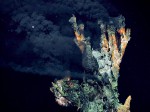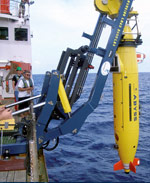
Massive sulphides in smoky depths
Sulphides
Sulphides are chemical compounds of sulphur and metal. The components of massive sulphides include iron sulphide (pyrite), copper sulphide (chalcopyrite), and zinc sulphide (sphalerite), as well as sulphides of other metals such as gold and silver. The relatively high content of precious metals makes the massive sulphides promising for ocean mining.A very hot stream of water
Beside manganese nodules and cobalt crusts, a third type of metal-bearing mineral resource is found in the sea: massive sulphides. They consist of sulphur compounds, sulphides, which form massive deposits on the sea floor similar to cobalt crusts – thus the name. Massive sulphides originate at hot vents in the ocean where sulphide-enriched water flows out of the seabed.
These sites of escaping hot water are called hydrothermal vents. They are found along plate boundaries and at active undersea volcanoes, where the exchange of heat and elements between the crustal rocks and the ocean takes place due to interactions between the volcanic activity and seawater. Seawater penetrates several thousand metres into the bottom through fissures in the sea floor. At these depths the seawater is heated to temperatures of around 400 degrees Celsius by volcanic activity, whereupon it dissolves metals and sulphur from the ambient volcanic rocks. The heated water is less dense than the cooler water above, so it rises quickly and flows back into the sea. In the ocean, the plume of hot water cools again rapidly. This causes the dissolved metals to bind into minute sulphide particles and sink as fine precipitants to the bottom.
 2.26 > Distribution of hydrothermal vents by depth and type of origin.
2.26 > Distribution of hydrothermal vents by depth and type of origin.- At many hydrothermal vents around the world the sulphides have accumulated to form tall chimney-like structures on the sea floor. Water shoots out of the fissures into the sea like a fountain. More and more material is gradually deposited on the sides of the openings and the tower continues to grow. Because of their appearance, these structures are also called smokers. As the escaping water is usually black-coloured by the minerals it contains, they are also called black smokers.
The first black smokers were discovered in 1979 during an expedition to the East Pacific Rise. They caused a sensation not only for eologists, but also for biologists because they were found to be populated by a diverse animal community. Scientists had not expected to find so much life in the deep sea. At that time it was considered to be a bleak and empty landscape.
Hydrothermal vents have now been found in all oceans. They usually form in water depths between 1000 and 4000 metres.
- 2.27 > Smokers form in magmatically active ocean regions. Water seeps through fractures in the sea bottom to depths of several thousand metres. Near magma chambers it is warmed to around 400 degrees Celsius and dissolves minerals from the rocks. Because of its low density it rises again and shoots out of the smoker back into the sea. Reaction with the cold seawater causes the formation of mineral particles that are then deposited onto the chimneys of the smoker or the nearby sea floor.
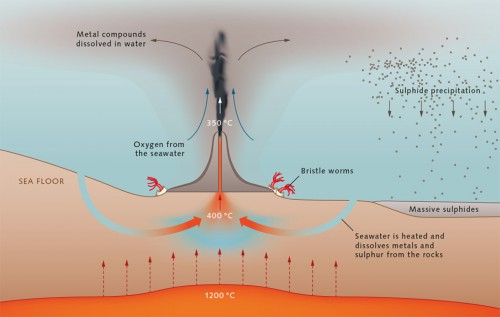
- Massive sulphides occur around the world at plate boundaries. Geologists distinguish 4 different typical areas of origin for hydrothermal vents and the associated massive sulphides: AT MID-OCEAN RIDGES: Mid-ocean ridges are mountain ranges in the ocean that circle the globe like the seam on a baseball. This is where the oceanic plates are drifting apart. The separation produces fractures in the seabed through which water sinks to great depths to be heated at magma chambers. AT ISLAND-ARC VOLCANOES: Island-arc volcanoes are formed when one oceanic plate is forced beneath another one under the sea. The subducted rocks melt at great depths and then rise as magma. Over time a large volcano grows. As long as the volcano does not reach the sea surface, it is called a seamount. Hydrothermal vents can form near the crowns of these underwater volcanoes. Many islands in the southwest Pacific have formed by this kind of subduction of oceanic plates and the rising of magma. There are usually a number of these volcanoes lined up in an arc along the subducting plate boundary because of the spherical form of the Earth. They are then called island arcs. VOLCANOES BEHIND ISLAND ARCS (back-arc basins): When one plate submerges beneath another, tension is produced in the overlying plate. Subduction of the sinking plate causes the overlying plate to thin and pull apart, until it finally splits open. In many cases this kind of tension occurs several dozen kilometres behind the active island-arc volcanoes. This area is therefore referred to as the back-arc basin. AT INTRAPLATE VOLCANOES: In addition to plate boundaries and subduction zones, volcanoes also form in the plate interiors. In these cases magma rises through fissures, burning its way through the Earth’s crust like a blowtorch. Because they form at individual sites or points, they are called hotspots. Single, isolated hydrothermal vents can also be found at these hotspots. The Hawaiian island group is an example of intraplate volcanoes. It was formed as the oceanic plate slowly moved across the hotspot. At various points magma has erupted to build up the islands.
Uncounted hydrothermal vents
To date, expeditions have discovered around 187 active hydrothermal vents with massive sulphides. An additional 80 known hydrothermal vents are no longer active, but massive sulphides are found here that were deposited in the past. Furthermore, 30 sites are known where high-temperature hydrothermal solutions flow out of the seabed but no massive sulphides have formed. There could, however, be sulphide deposits below the surface here. So there are a total of around 300 hydrothermal vents or massive sulphide deposits known today. 58 per cent of these are located at mid-ocean ridges, 26 per cent at the back-arc spreading zones, 16 per cent at island-arc volcanoes, and one per cent on intraplate volcanoes.
Researchers assume that the worldwide number of hydrothermal vents, and thus of massive sulphides, is much larger. This is based on estimates of the geothermal heat flux of the Earth. The amount of heat generated in the Earth’s interior and that released by magmatism and volcanism is accurately known today. This heat amounts to 1.8 trillion watts, equivalent to the output of one million nuclear power plants. According to the estimates, a portion of the heat is released through hydrothermal vents. Based on the calculations, some researchers reckon that there is one hydrothermal vent for every kilometre of mid-ocean ridge or back-arc spreading zone. Considering that the mid-ocean ridges and back-arc spreading zones together have a total length of about 67,000 kilometres, and the island-arc volcanoes a length of around 22,000 kilometres, there could be around 90,000 hydrothermal vents worldwide. Researchers assume that large areas may be found every 50 to 100 kilometres that contain up to 100 black smokers. It is predicted that there are around 500 to 1000 sites around the world with large massive sulphide deposits.
- 2.28 > The number of hydrothermal vents is difficult to determine because they are dispersed around the world. 187 active and 80 inactive hydrothermal vents where massive sulphides have formed are known to exist.
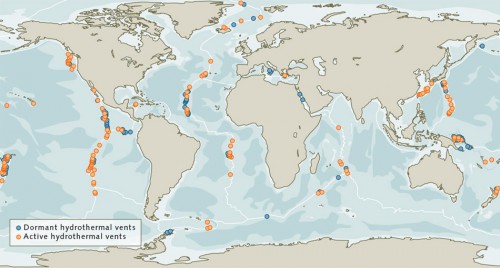
- 2.29 > Hydrothermal vents develop in different kinds of magmatically active areas where water penetrates to great depths and is heated. These areas include island-arc volcanoes, for example, which are formed when rocks plunging far below the sea floor are melted. Behind the island arcs, the seabed ruptures due to the spreading motion of the Earth’s crust, allowing magma to rise. Mid-ocean ridges form when oceanic plates drift apart. Intraplate volcanoes, on the other hand, originate at weak points in the crust.
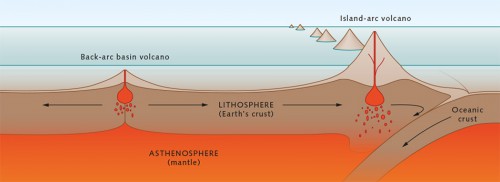
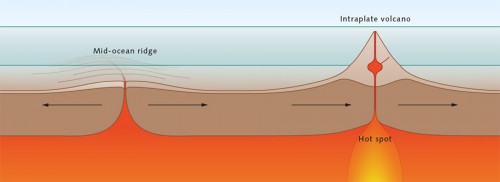
- The size and metal content of massive sulphides, however, are difficult to measure. This is because the hot-water plume escaping from active smokers disperses rapidly and the sulphides, in part, are carried away by the currents. Massive sulphide areas extending 10 to hundreds of metres can thus be formed that contain several million tonnes of massive sulphides. At a single glance, however, it is not possible to tell how large an occurrence is; this requires bottom samples or drill cores. This costly sampling process is also necessary to determine the metal content.
Based on the analyses of many bottom samples carried out in recent decades, researchers believe that massive sulphide deposits containing valuable metals such as copper and gold that are actually large enough for economic mining occur at relatively few hydrothermal vents. Moreover, many of the regions are in rough terrain that is unsuitable for the mining equipment.
Extra Info The challenging search for hydrothermal vents and profitable massive sulphide deposits

- Geological studies have shown that large deposits can only form when one or more of the following conditions are met:
- The hydrothermal vent was active for at least several tens of thousands of years, giving time for a sufficient amount of material to accumulate.
- The plates at the mid-ocean ridge or in the back-arc basin may only spread apart at very slow rates. Otherwise new fissures would constantly be forming with numerous small vents, and no single site with large amounts of sulphide enrichment could develop. Projections suggest that 86 per cent of all massive sulphide deposits occur at fractures where the plates are spreading apart at the low rate of no more than 4 centimetres per year. Only 12 per cent of the massive sulphide deposits are found at rifts where the spreading rate is 4 to 8 centimetres per year. In addition, these deposits are usually smaller in size. Very few massive sulphide deposits occur at rifts with more rapidly spreading plates (greater than 8 centimetres per year).
- The hydrothermal vent is covered by sediments, which are enriched from below by sulphides rising from the subsurface. In this situation the fine sulphide particles form when the hot water reacts with the cooler water in the pores of the sediments. The metals can be highly enriched in such sediments because the sulphides are not dispersed by water currents, as they are at black smokers. There are, however, very few known deposits of this kind.
More precious than nodules and crusts
Compared to the billions of tonnes of manganese nodules and cobalt crusts, the estimated amounts of massive sulphides, at a total of a few hundred million tonnes, are much smaller. Estimates of the total amounts are extremely difficult, however, because to date only a fraction of the total occurrences have been discovered. Furthermore, presumably not all of the estimated 500 to 1000 large occurrences can yield valuable metals. The massive sulphide occurrences of the East Pacific Rise, and in part those of the Mid-Atlantic Ridge, contain mostly iron sulphide, which has no economic value.
The deposits in the Bismarck Sea east of Papua New Guinea are one example of economically promising massive sulphides. They have high contents of copper and zinc. The contents of gold and silver are also considerable. The concentration of gold in some of the deposits here is around 15 grams per tonne. That is about 3 times as much as in typical deposits on land. The silver content here is commonly between 100 and 300 grams per tonne, with peak values of 642 grams per tonne in the Solwara Field in the western Bismarck Sea. This is significantly higher than the concentrations in manganese nodules and cobalt crusts, which only reach values of about one gram of silver per tonne. The highest proportions found on land are 100 to 160 grams of silver per tonne.
Many chemical elements are found in relatively small amounts in massive sulphides, including manganese, bismuth, cadmium, gallium, germanium, antimony, tellurium, thallium and indium. In some deposits, however, especially at island-arc volcanoes, these elements can be more highly concentrated.
- 2.31 > Massive sulphides are notable for their high gold and silver content, which in part greatly exceeds that of manganese nodules and cobalt crusts. But by no means every massive sulphide occurrence is rich in precious metals. Even within a single region such as the Manus Basin of Papua New Guinea, occurrences are found with highly variable gold and silver contents.
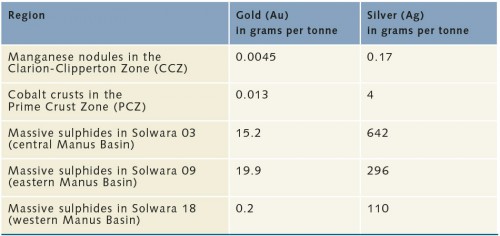
- Which metals are contained in the massive sulphides and at what concentrations depends principally on the composition of the rocks beneath the hydrothermal vents and on the temperature of the escaping water. The contents fluctuate, therefore, not only from region to region, but also within a single massive sulphide occurrence or at an individual black smoker. This is because the temperature drops with increasing distance from the hydrothermal vent. Minerals that are rich in copper often form in the core of the smoker. In the outer zone of the porous smokers the hot fluids are mixed with the cold seawater, and minerals with other metals are deposited, for example pyrite, sphalerite, or marcasite, which are rich in iron and zinc. This zonation is also observable at larger scales: at the margins of massive sulphide occurrences the smokers have lower outflow temperatures, so these precipitate different minerals. Because expeditions in the past have often only taken massive sulphide samples directly from the chimneys themselves, it is still not well known how the metals are distributed within an area. The composition of the massive sulphides varies not only with distance from the hot vent, however, but also with depth, and there is little data available regarding this. Only small numbers of expeditions or research ships have special drilling equipment available for taking samples. In order to assess how profitable a deposit is and how high the metal content is, much additional drilling will be necessary in the future.
- 2.32 > Water at temperatures of up to 380 degrees Celsius is released at black smokers. It contains sulphides, sulphur compounds that give a dark colour to the water.
First activity in the South Pacific
Like the cobalt crust occurrences, important massive sulphide deposits are found not only in international waters of the high seas, but also in the Exclusive Economic Zones (EEZ) of a number of island states. Here the appropriate local governments and not the International Seabed Authority will determine the conditions for future extraction activities.
Plans for mining in the Bismarck Sea off Papua New Guinea are already at an advanced stage. The government there is working with a Canadian company which, in turn, includes participation by large commodities companies from Canada, Russia and South Africa. The plans were temporarily on hold due to arbitration proceedings related to the payment of project costs. An arbitrator was finally able to bring the parties to an agreement in October 2013. It now appears that a contract will be awarded to a shipyard in the spring of 2014 for the construction of a special ship for massive sulphide mining. The seabed crawlers for working on the bottom have already been built. In the future, vehicles weighing from 3 to 300 tonnes will be used: one large and one small rock cutter plus a collecting machine to retrieve the pieces of massive sulphide. According to the manufacturer, the technical challenges can be easily overcome. The company has been producing heavy crawler vehicles called trenchers that are used to lay underwater cables. These have been operated in even deeper waters. The rock mixture will be pumped from the collecting machine into a large container that rises and sinks between the ship and sea floor. The container is filled with blocks of massive sulphides on the bottom and then raised to the ship, emptied, and lowered to the sea floor again. The partners expect mining operations to begin around 2016.
- 2.33 > Off Papua New Guinea, the mining of massive sulphides should begin by 2016. The heavy chassis of the rock cutter, which will work on the sea floor, is ready.
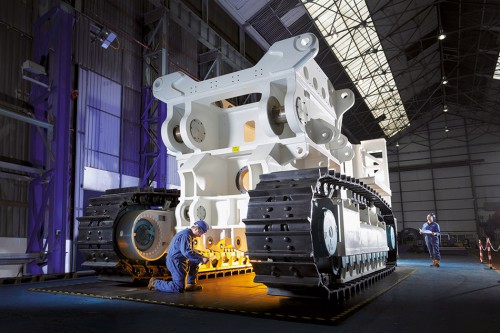
Limited exploration licences
Comparable progress has not been achieved in international waters because exploration and mining there are centrally regulated and coordinated by the ISA. Licences have already been awarded to China and South Korea for areas in the Indian Ocean, and to France and Russia for areas on the Mid-Atlantic Ridge. Other states have just recently applied for, or will soon apply for exploration licences. Germany is planning for the Indian Ocean, for example. The ISA will first have to rule on these applications. Overall, however, the same scenario is expected for massive sulphide deposits as will likely occur for the mining of cobalt crusts and manganese nodules: while mining in international waters will not happen in the immediate future, individual states, in cooperation with mining or resource concerns, could get a head start by beginning to mine in their own EEZs. For Papua New Guinea, for example, mining is interesting because the massive sulphide deposits off their coast have high gold and silver contents.
Extreme habitat, many specialized species
Hydrothermal vents are not only providers of resources, but also extraordinary habitats. In spite of the hostile conditions, such as temperatures over 350 degrees Celsius and the slightly acidic hydrothermal fluids enriched in toxic metal compounds, a unique natural community has evolved here over millions of years, perfectly adapted to the inhospitable environment.
Normally the sun is the source of energy for life in the ocean. It causes algae to flourish, which use the sunlight and photosynthesis to construct high-energy molecules like sugar. This is called primary production, and is the base of the food web in the ocean.
But it is dark at the hydrothermal vents. Primary production here is performed by chemoautotrophic bacteria, which exploit the energy-rich chemical compounds found at the hydrothermal vents and alter them into molecules that can also be used by other organisms. The bacteria can endure water temperatures greater than 100 degrees Celsius and thus occur near the smokers. The bacteria or the products of their metabolism provide nourishment for higher organisms such as mussels, and these in turn for other organisms. Communities with up to 600 different species can thus be found at the vents, including, for example, snails of the genus Alviniconcha, which can tolerate temperatures up to 45 degrees Celsius. Many of these animal groups live exclusively at hydrothermal vents. Because of the continuous influx of nutrients, the organisms are present in great numbers. Expeditions have sometimes recorded hundreds to thousands of animals within one square metre of sea floor.
What is rare?
Whether there are endemic species living at the hydrothermal vents in the deep sea that only occur in a limited area, or in extreme cases only at a single massive sulphide deposit, is a vital question for mining, because it could bring about their extinction. Biologists are thus trying to determine the extent of distribution of certain species – whether they live in a larger oceanic region like the Indian Ocean at numerous hydrothermal vents or are limited to a smaller region such as the Bismarck Sea.
In fact, scientists have found differences between different ocean regions. Large tube worms predominate in areas of the eastern Pacific, but have never been found in the Atlantic or Indian Oceans, or in the southwest Pacific. At the Mid-Atlantic Ridge, on the other hand, large numbers of deep-sea shrimps are found living with symbiontic chemoautotrophic bacteria on their bodies, which provide them with nutrients. And finally, in the Indian Ocean, deep-sea shrimps as well as anemones and snails are found with symbiontic bacteria.
Because of the various discoveries, attempts have been made to categorize hydrothermal vents into bio- geographic provinces based on similarities of the biological communities and the geological structures. To this end researchers have interpreted data from expeditions and used statistical methods to compare individ- ual organism counts from 63 hydrothermal vents.
- According to this analysis there are 6 different provinces in which, to a large extent, different species occur. The provinces are the Northwest Pacific, the Southwest Pacific, Northeast Pacific, Northern East Pacific Rise, Southern East Pacific Rise, and the Northern Mid-Atlantic Ridge.
Of course, to some degree, related or even the same species occur in different provinces. The researchers have thus tried to discover whether and how species have been able to disperse over thousands of years from one province to another. The East Pacific Ridge appears to play a central role as a kind of hub of species dispersal. It must be kept in mind here, however, that more and more differences are being identified between similar species through modern genetic studies, and at many sites such genetic investigations have not yet been carried out. It is still uncertain whether some apparently indistinguishable species are truly identical.
- 2.35 > Different animal species predominate in the hydrothermal vent habitats of the various worldwide marine regions. Through statistical analyses of the fauna at 63 hydrothermal vents, researchers were able to identify 6 bio-geographic provinces with clearly different species assemblages.
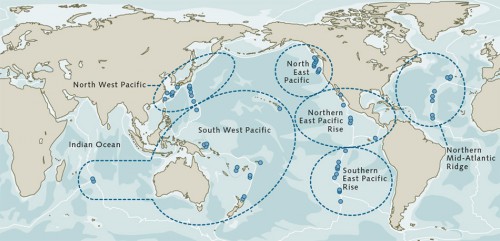
- Besides the species that are adapted in special ways to the hydrothermal fluids, there are also serious threats to those that are found on the massive sulphides of dormant hydrothermal vents. This habitat is colonized, for example, by deep-sea corals, sponges and barnacles. Similar to other deep-sea organisms, these are rare, grow very slowly, and produce few offspring. For these reasons they are especially endangered. If the parent animals die, then there are sparse young remaining to rebuild the stocks.
Generally speaking, there is still very little known today about the biology of deep-sea animals. There are still questions that must be answered before we can understand how and whether animal communities can recover after a disturbance on the scale of massive-sulphide mining. It is, for example, still unknown how abundant or rare the species are, in which habitats they live, how far apart these habitats are, and how or whether the animals can spread from one habitat to another. Only then would a recolonization of harvested areas be possible at all.
Before the mining begins …
To minimize as far as possible the damage that could result from the mining of massive sulphides, experts suggest carrying out additional studies to determine the extent to which endemic species could be affected. This would necessitate distinguishing between massive sulphides at active hydrothermal vents and old massive sulphides at dormant vents. Because of the extreme level of specialization by denizens of the hydrothermal vents, they are assumed to be more likely to live in narrowly limited ocean regions and be endemic. The normal, common deep-sea species are more widely distributed. Because of their slow growth and low number of offspring, however, special care must be taken to prevent eradication of entire local stocks. Both of these kinds of species would presumably have a greater chance if the deposits were only partly harvested, preserving areas from which the harvested areas could be recolonized. Alternatively, massive sulphides could be exclusively produced in areas where it is known that other hydrothermal fields exist nearby that host the same species assemblages.
